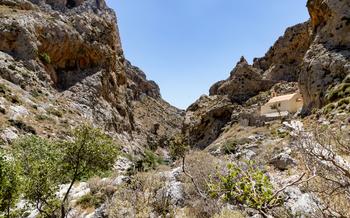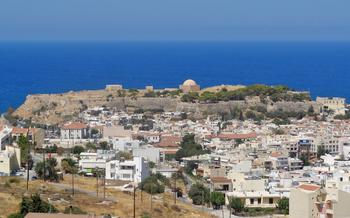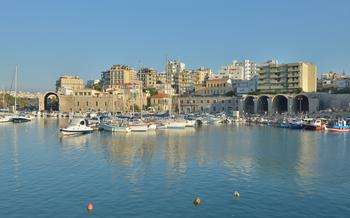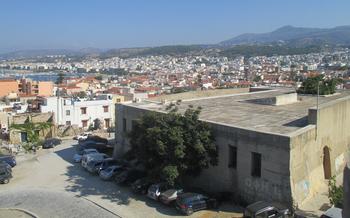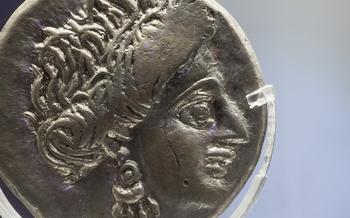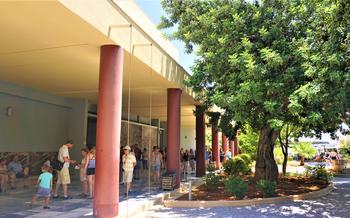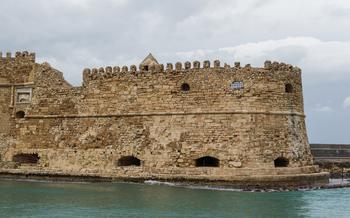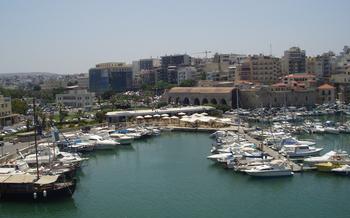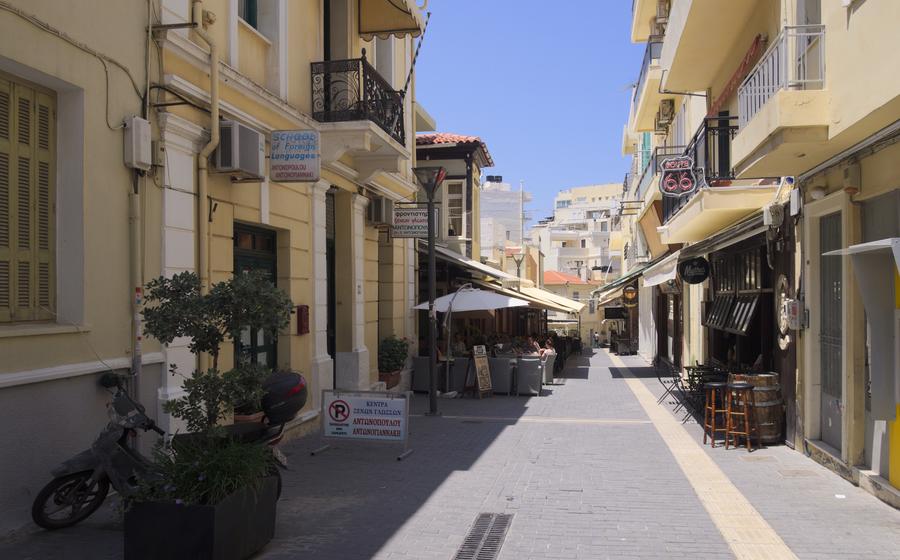
Rouvas Forest and Gorge
- Rouvas Forest: A Haven of Natural Beauty
- How to Get to Rouvas Forest and Gorge
- Public Transportation
- Driving Directions
- Guided Tours
- Recommended Starting Point
- Best Time to Visit Rouvas Forest and Gorge
- What to Wear and Bring
- Hiking Trails in Rouvas Gorge
- Exploring Rouvas Forest
- Rouvas Gorge Highlights
- The Gates of Hades
- Natural Pools and Waterfalls
- Ancient Minoan Settlements
- Abandoned Watermills
- Rouvas Forest Highlights
- The Rouvas Monastery
- The Venetian Fortress
- The Ancient Olive Groves
- The Local Vineyards
- Local Cuisine and Restaurants
- Accommodation Options Near Rouvas Forest and Gorge
- Safety Tips for Hiking in Rouvas Gorge
- History and Legends of Rouvas Forest and Gorge
- Responsible Tourism in Rouvas Forest and Gorge
- Insider Tip: Hidden Gems
Rouvas Forest: A Haven of Natural Beauty
Nestled within the mountainous landscapes of Crete, the Rouvas Forest (Dasos Rouva) stands as a testament to the island's rich natural heritage. Steeped in historical significance, the forest has played a vital role in shaping the island's identity. Once a royal hunting ground, Rouvas Forest served as a sanctuary for the rulers of ancient Crete, who sought solace and recreation amidst its tranquil surroundings.
Situated in the Heraklion region, the Rouvas Forest is easily accessible from the city, providing a convenient escape into nature. Covering an area of over 10 square kilometers, the forest boasts a diverse ecosystem that encompasses a wide variety of plant and animal species. Visitors can marvel at the towering cypress trees, fragrant pines, and lush oak groves that dominate the landscape. The forest also provides a habitat for numerous animal species, including the Cretan wild goat, the golden eagle, and various species of reptiles and amphibians.
Among the must-see spots within the forest is the Venetian Fortress, a historical landmark that dates back to the 13th century. This well-preserved fortress offers panoramic views of the forest and the surrounding mountains. Another highlight is the Rouvas Monastery, a spiritual retreat built in the 16th century. The monastery's serene atmosphere and stunning architecture make it a popular destination for pilgrims and visitors alike.
How to Get to Rouvas Forest and Gorge
Reaching Rouvas Forest and Gorge is relatively straightforward, offering various transportation options to suit your preferences and budget.
Public Transportation
Public buses provide a convenient and budget-friendly way to reach Rouvas Forest and Gorge. Buses depart from Heraklion's main bus station and make regular stops in the nearby villages of Zaros, Vorizia, and Rouvas. From these villages, you can either walk or take a short taxi ride to the trailheads.
Driving Directions
If you prefer the flexibility of driving, rental cars are readily available in Heraklion. Follow the signs towards Zaros, and then continue on the scenic mountain road until you reach the village of Rouvas. Ample parking is available near the trailheads, allowing you to start your adventure without hassle.
Guided Tours
For those who prefer a more structured experience, guided tours are an excellent option. Local tour operators offer guided hikes and excursions to Rouvas Forest and Gorge, providing insightful commentary and ensuring your safety throughout the journey.
Recommended Starting Point
The most popular starting point for exploring Rouvas Forest and Gorge is the village of Rouvas. From here, you can easily access the main hiking trails and immerse yourself in the natural beauty of the area.
Best Time to Visit Rouvas Forest and Gorge
The ideal time to visit Rouvas Forest and Gorge depends on your preferences and priorities. Each season offers unique experiences and challenges.
Spring (April-May): - Weather: Pleasant temperatures, with an average high of 20-25°C (68-77°F). - Tourist Seasons: Moderate crowds, allowing for a more peaceful exploration. - Wildlife Sightings: Spring is the best time to spot migratory birds and wildflowers in bloom. - Optimal Hiking Conditions: Comfortable temperatures and fewer slippery surfaces make hiking more enjoyable.
Summer (June-August): - Weather: Hot and dry, with an average high of 28-35°C (82-95°F). - Tourist Seasons: Peak season, with larger crowds and higher prices. - Wildlife Sightings: Fewer bird sightings but increased chances of spotting reptiles and amphibians. - Optimal Hiking Conditions: Early morning or late evening hikes are recommended to avoid the midday heat.
Autumn (September-October): - Weather: Mild temperatures, with an average high of 20-25°C (68-77°F). - Tourist Seasons: Fewer crowds, making it an ideal time for a tranquil visit. - Wildlife Sightings: Autumn is a great time to observe birds of prey and migrating birds. - Optimal Hiking Conditions: Pleasant temperatures and fewer slippery surfaces make hiking enjoyable.
Winter (November-March): - Weather: Cool and wet, with an average high of 10-15°C (50-59°F). - Tourist Seasons: Low season, with fewer visitors and lower prices. - Wildlife Sightings: Fewer wildlife sightings due to hibernation and migration. - Optimal Hiking Conditions: Hiking is still possible, but trails may be slippery and muddy.
Our Recommendation: For the best balance of weather, wildlife sightings, and fewer crowds, we recommend visiting Rouvas Forest and Gorge in Spring (April-May) or Autumn (September-October).
What to Wear and Bring
Clothing and Footwear:
Choose comfortable, lightweight, and moisture-wicking clothing that allows for freedom of movement. Long-sleeved shirts and pants are recommended for sun protection and to avoid insect bites. Sturdy hiking boots with good ankle support are essential for navigating the uneven terrain.
Hydration and Snacks:
Bring plenty of water to stay hydrated, especially during the hot summer months. Pack nutritious snacks such as energy bars, trail mix, or fresh fruits to replenish your energy levels during your hike.
Sun Protection:
The Greek sun can be intense, so protect yourself from harmful UV rays with sunscreen, a hat, and sunglasses. Reapply sunscreen regularly, especially after swimming or sweating.
Camera and Binoculars:
Capture the stunning scenery, wildlife, and historical landmarks with a camera. Bring binoculars to get a closer look at the unique flora and fauna of the gorge.
Hiking Trails in Rouvas Gorge
The Rouvas Gorge is a hiker's paradise, with a variety of trails catering to different levels of experience and fitness. The most popular trail is the E4 European Long Distance Path, which traverses the entire gorge and offers stunning views of the surrounding landscape. The trail is well-marked and maintained, making it suitable for hikers of all abilities.
For a more challenging experience, the Rouvas Gorge Trail is a must-try. This trail follows a steep and narrow path along the gorge walls, providing hikers with a thrilling adventure. The trail is not for the faint of heart, but the rewards are immense, with breathtaking views and a sense of accomplishment.
For those looking for a more leisurely walk, the Agia Paraskevi Trail is an excellent option. This trail leads to the beautiful Agia Paraskevi Chapel, which is nestled amidst a lush forest. The trail is mostly flat and easy to navigate, making it ideal for families with young children or for those who prefer a more relaxed hiking experience.
In addition to these main trails, there are numerous other paths and side trails that can be explored in the Rouvas Gorge. These trails offer a variety of experiences, from easy walks through the forest to challenging climbs up steep cliffs. With so many options to choose from, hikers of all levels can find the perfect trail to suit their needs and abilities.
Exploring Rouvas Forest
Rouvas Forest, with its enchanting allure, beckons nature enthusiasts to embark on a journey of discovery through its verdant expanse. Immerse yourself in the tranquility of the forest as you traverse its meandering paths, each step revealing a tapestry of natural wonders.
Pause at one of the many viewpoints to soak in the panoramic vistas that stretch before you. Gaze upon the lush greenery that carpets the hillsides, the shimmering waters of the lake, and the distant peaks that pierce the azure sky.
Find respite from the sun's embrace beneath the shade of ancient trees, their gnarled branches reaching towards the heavens. Let the gentle breeze rustle through the leaves, creating a symphony of sound that soothes the soul.
Unveil the hidden secrets of Rouvas Forest as you encounter historical and cultural landmarks that dot the landscape. Discover the remnants of ancient civilizations, where time-worn stones whisper tales of bygone eras.
Immerse yourself in the vibrant tapestry of local flora and fauna. Observe the graceful flight of birds as they soar above the treetops, their melodious songs filling the air. Encounter the shy creatures that inhabit the forest, their eyes sparkling with curiosity as they watch you pass.
Rouvas Forest is a sanctuary for the soul, a place where you can reconnect with nature and find solace in its embrace. Let its beauty captivate your senses and create memories that will last a lifetime.
Rouvas Gorge Highlights
The Gates of Hades
Rouvas Gorge boasts a remarkable rock formation known as the "Gates of Hades." According to Greek mythology, this formation represents the entrance to the underworld, where the god Hades ruled over the dead. It is a stunning natural wonder that evokes a sense of awe and mystery.
Natural Pools and Waterfalls
The gorge is home to a series of natural pools and waterfalls that create a refreshing and picturesque setting. These crystal-clear pools invite visitors to take a dip and cool off during the hot summer months. The sound of cascading water adds to the tranquility and serenity of the environment.
Ancient Minoan Settlements
Within the gorge, visitors can discover the ruins of ancient Minoan settlements, dating back to the Bronze Age. These settlements provide a glimpse into the history and culture of the Minoans, one of the earliest civilizations in Europe. Exploring these ancient ruins offers a unique opportunity to connect with the past.
Abandoned Watermills
The gorge also features abandoned watermills, remnants of a bygone era. These structures, once used to grind grain, now stand as silent witnesses to the region's agricultural heritage. Their presence adds a touch of nostalgia and charm to the landscape.
Rouvas Forest Highlights
The Rouvas Monastery
Nestled amidst the lush greenery of Rouvas Forest, the Rouvas Monastery stands as a testament to the region's rich religious history. Founded in the 16th century, this Byzantine-style monastery exudes an aura of serenity and spirituality. Explore its well-preserved frescoes, intricate iconography, and peaceful courtyards, where time seems to stand still.
The Venetian Fortress
A strategic stronghold from the Venetian era, the Venetian Fortress proudly overlooks Rouvas Forest. Constructed in the 16th century to protect against pirate raids, this impressive fortification features thick stone walls, imposing towers, and a captivating history. Wander through its remnants, imagining the battles and sieges that unfolded within its walls, and soak in the panoramic views of the surrounding countryside.
The Ancient Olive Groves
Rouvas Forest is home to sprawling olive groves, a testament to the region's deep-rooted agricultural traditions. These ancient trees, some dating back centuries, produce olives of exceptional quality, renowned for their rich flavor and golden-green hue. Stroll through the groves, marveling at their gnarled trunks and silvery foliage, and learn about the intricate process of olive cultivation and harvesting.
The Local Vineyards
The fertile slopes of Rouvas Forest are also home to a number of vineyards, where local vintners cultivate grapes under the warm Mediterranean sun. Indulge in wine tasting sessions at local wineries, sampling the region's distinctive vintages. From crisp whites to robust reds, these wines showcase the unique terroir of Rouvas Forest, offering a delightful journey for your palate.
Local Cuisine and Restaurants
Rouvas Forest and Gorge offer a delightful culinary adventure, with traditional Cretan dishes that showcase the region's rich flavors and fresh ingredients. Savor the authentic taste of Crete by indulging in dishes like dakos, a refreshing salad made with barley rusks, tomatoes, feta cheese, and olive oil; gamopilafo, a celebratory rice dish with lamb or goat meat; and kalitsounia, delicious pastries filled with cheese, herbs, or vegetables.
For a memorable dining experience, visit the traditional tavernas and restaurants nestled in the picturesque villages surrounding the forest and gorge. These charming establishments offer panoramic views, warm hospitality, and mouthwatering dishes prepared with locally sourced ingredients. Don't miss the chance to sample the region's renowned olive oil, produced from centuries-old olive groves, and the exquisite local wines.
If you prefer a picnic amidst the serene natural surroundings, pack a hamper with local delicacies and find a secluded spot in the forest or by the river. Enjoy a leisurely meal surrounded by the beauty of nature, savoring the flavors of Crete in a truly unique setting.
After your adventures in Rouvas Forest and Gorge, treat yourself to some local delights. Visit the village markets to discover an array of fresh produce, artisanal cheeses, and homemade sweets. Don't forget to bring back some of these culinary treasures to share with friends and family, or as a reminder of your unforgettable journey in Crete.
Accommodation Options Near Rouvas Forest and Gorge
For a comfortable stay near Rouvas Forest and Gorge, there are several accommodation options available to suit different preferences and budgets.
-
Hotels and Guesthouses: In the nearby towns and villages, various hotels and guesthouses offer cozy rooms with modern amenities. These establishments often provide stunning views of the surrounding landscape, making for a serene and memorable stay.
-
Camping Facilities: For those who prefer a more rustic experience, there are designated camping areas within the Rouvas Forest. These campsites offer basic amenities such as restrooms, showers, and picnic tables, allowing visitors to immerse themselves in the natural surroundings.
-
Agrotourism Experiences: To fully embrace the local culture, consider staying at an agrotourism farm in the region. These accommodations provide a unique opportunity to learn about traditional farming practices, savor homemade Cretan cuisine, and enjoy the tranquility of the countryside.
-
Unique Accommodations: For a truly unforgettable experience, opt for one of the unique accommodations in the area. These may include charming guesthouses housed in restored historical buildings, treehouses nestled amidst the forest, or even traditional stone cottages offering a glimpse into the past.
Safety Tips for Hiking in Rouvas Gorge
Venturing into Rouvas Gorge requires proper preparation and adherence to safety guidelines. Here are some essential tips to ensure a safe and enjoyable hiking experience:
-
Proper Footwear and Clothing: Wear sturdy hiking boots with good traction to navigate the uneven terrain. Avoid slippery sandals or flip-flops. Dress in layers to adjust to changing temperatures and pack a raincoat in case of rain.
-
Avoiding Slippery Rocks: Be cautious when crossing streams or walking on wet rocks, as they can be slippery. Use trekking poles for added stability and grip.
-
Water Safety Precautions: The natural pools in the gorge may look inviting, but be aware of the water depth and currents before diving in. Avoid swimming alone, and supervise children closely.
-
First Aid and Emergency Contacts: Bring a basic first aid kit containing essential supplies. Familiarize yourself with emergency contact numbers and the nearest medical facilities.
History and Legends of Rouvas Forest and Gorge
Rouvas Forest and Gorge hold a rich tapestry of history and legends that intertwine with the natural beauty of the region. In ancient times, the area was believed to be the gateway to the underworld, with the "Gates of Hades" rock formation said to mark the entrance to the realm of the dead. According to Greek mythology, the hero Theseus journeyed through the gorge to rescue his friend Pirithous from the clutches of the god of the underworld, Hades.
Over the centuries, the forest and gorge have been the stage for numerous historical events and battles. In the Venetian era, the area was a strategic stronghold, with the Venetians constructing a fortress to protect their interests in the region. During the Ottoman occupation, the gorge served as a hideout for freedom fighters resisting Turkish rule.
Local traditions and folklore are deeply intertwined with the history of the region. The Rouvas Monastery, nestled within the forest, is said to have been founded by a monk who sought refuge from the Ottomans. The abandoned watermills along the gorge are a testament to the region's rich agricultural heritage.
Archaeological discoveries in the area have shed light on the ancient civilizations that inhabited the region. Minoan settlements and artifacts have been found, providing glimpses into the lives of the island's early inhabitants. These discoveries have further enriched the historical and cultural significance of Rouvas Forest and Gorge.
Responsible Tourism in Rouvas Forest and Gorge
As you embark on your adventure in Rouvas Forest and Gorge, it's essential to embrace responsible tourism practices to preserve the natural beauty and cultural heritage of this remarkable place.
Minimize Your Environmental Impact: Embrace the "leave no trace" principle by packing out all your waste and avoiding the use of single-use plastics. Opt for reusable water bottles and containers to stay hydrated.
Respect Local Customs and Traditions: Be mindful of local customs and traditions. Dress appropriately when visiting religious sites, and ask permission before taking photographs of people or their property.
Support Local Businesses: Choose local restaurants, guesthouses, and tour operators to contribute to the local economy and support sustainable livelihoods. Purchase souvenirs from local artisans to promote traditional crafts.
Preserve the Natural Beauty: Refrain from picking flowers or plants and disturbing wildlife. Stay on designated trails to avoid damaging vegetation and erosion. Respect the fragile ecosystem by not leaving any graffiti or markings.
By embracing responsible tourism, you become an ambassador for the preservation of Rouvas Forest and Gorge. Your actions contribute to ensuring that future generations can continue to enjoy the pristine beauty and unique experiences this natural wonder offers.
Insider Tip: Hidden Gems
Beyond the well-known attractions, Rouvas Forest and Gorge offer a wealth of hidden gems waiting to be discovered. For those willing to venture off the beaten path, there are secluded trails leading to breathtaking viewpoints, secret swimming spots tucked away amidst the lush vegetation, and off-the-beaten-track cultural experiences that provide a glimpse into the authentic Cretan way of life.
One such hidden gem is the ancient Minoan settlement of Azoria, located deep within the forest. Here, visitors can explore the ruins of this once-thriving village, including its well-preserved houses, temples, and workshops. Another hidden gem is the abandoned village of Fodele, which offers a fascinating glimpse into the past with its traditional stone houses, narrow streets, and picturesque churches.
For those seeking a unique swimming experience, the natural pools formed by the waterfalls in Rouvas Gorge are a must-visit. These secluded spots offer a refreshing dip in crystal-clear waters surrounded by stunning scenery.
To truly immerse yourself in the local culture, visit the village of Rouvas, where you can interact with the friendly locals, sample traditional Cretan cuisine at family-run tavernas, and learn about the area's rich history and traditions.
Whether you're seeking solitude in nature, craving adventure, or simply looking for authentic cultural experiences, the hidden gems of Rouvas Forest and Gorge are sure to captivate and enchant you.
